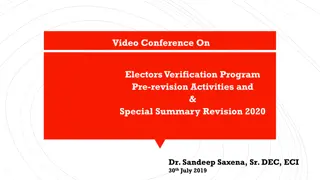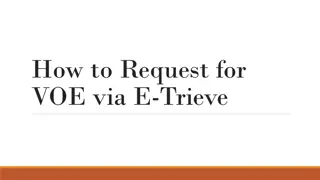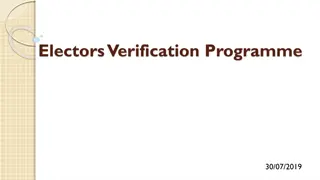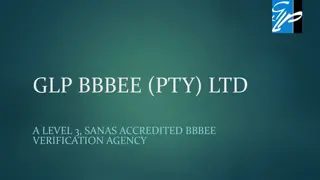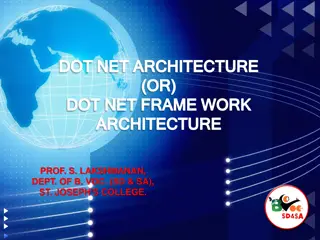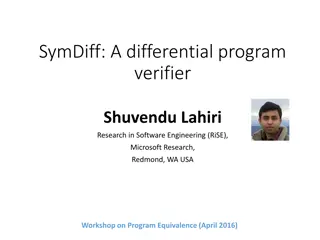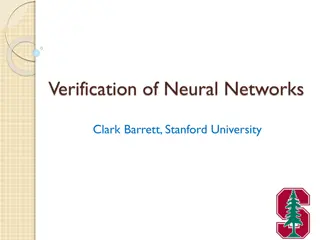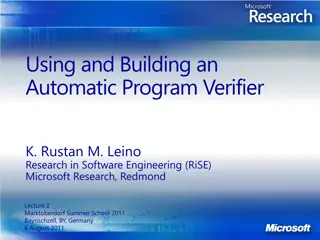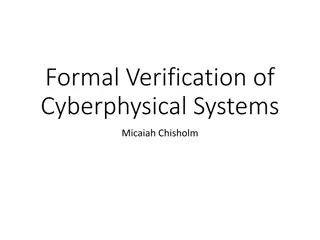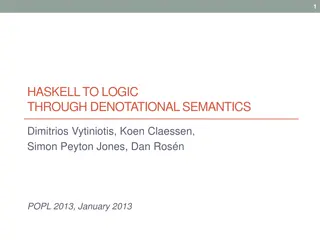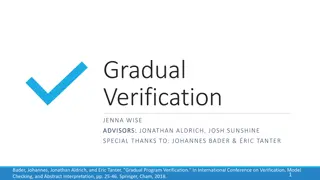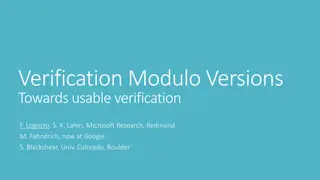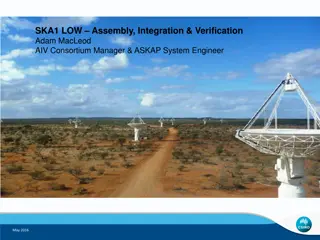Program Verification via an Intermediate Verification Language
Dive into the world of program verification through an intermediate verification language with a focus on static program verification, reasoning about programs, and separation of concerns. Explore tools like Dafny and verification architectures like Boogie and Why3, along with key concepts including Mathematical features, Imperative features, and Statement outcomes.
Download Presentation

Please find below an Image/Link to download the presentation.
The content on the website is provided AS IS for your information and personal use only. It may not be sold, licensed, or shared on other websites without obtaining consent from the author. Download presentation by click this link. If you encounter any issues during the download, it is possible that the publisher has removed the file from their server.
E N D
Presentation Transcript
Program Verification via an Program Verification via an Intermediate Verification Intermediate Verification Language Language K. Rustan M. Leino Principal Researcher Research in Software Engineering (RiSE), Microsoft Research, Redmond Visiting Professor Department of Computing, Imperial College London Guest lecture in Emina Torlak s CSE 507, Computer-Aided Reasoning for Software 4 May 2016, UW, Seattle, WA, USA
Static program verification What is the state-of-art in program verifiers? How to build a program verifier
Dafny Put reasoning about programs first Language aimed at reasoning Constructs for recording design decisions Tool support Static program verifier enforces design decisions Integrated development environment Tools help in reasoning process Verification is not an afterthought
(start + count) % data.Length 0 start data: Demo Enqueue at (start + count) % data.Length Dequeue at start Imperative programs: Queue implemented by a ring buffer
Copying into the new array 0 start data: more start 0 d:
Separation of concerns Intermediate verification language Intermediate representation
Verification architecture Boogie
Meet the family Boogie Verification Debugger Boogie inference SymDiff
Boogie language overview Mathematical features type T const x function f axiom E Imperative features var y procedure P spec implementation P { body }
Statement outcomes Terminate Go wrong Block Diverge
Boogie statements x := E Evaluate E and change x to that value a[i] := E Same as a := a[i := E] havoc x Change x to an arbitrary value assert E If E holds, terminate; otherwise, go wrong assume E If E holds, terminate; otherwise, block call P() Act according to specification of P if while break label: goto A, B
Translation basics Ada Boogie var x: int; x : Integer; procedure Update (y : Integer; r : out Integer) is begin if x < y then x := y; end if; r := y; end Update; procedure Main is begin Update(5, x); end Main; procedure Update(y: int) returns (r: int) modifies x; { if (x < y) { x := y; } r := y; } procedure Main() modifies x; { call x := Update(5); }
Unstructured control flow .NET bytecode (MSIL) Boogie var i: int, CS$4$000: bool; var $stack0i, $stack1i: int, $stack0b: bool; IL_0000: $stack0i := 0; i := 0; goto IL_000b; IL_0005: $stack1i := i; $stack0i := $stack0i + $stack1i; i := $stack0i; IL_000b: $stack0i := i; $stack1i := n; $stack0b := $stack0i < $stack1i; CS$4$000 := $stack0b; $stack0b := CS$4$000; if ($stack0b) { goto IL_0005; } IL_0013: return; .maxstack 2 .locals init ([0] int32 i, [1] bool CS$4$0000) IL_0000: nop IL_0001: ldc.i4.0 IL_0002: stloc.0 IL_0003: br.s IL_000b IL_0005: nop IL_0006: ldloc.0 IL_0007: ldc.i4.1 IL_0008: add IL_0009: stloc.0 IL_000a: nop IL_000b: ldloc.0 IL_000c: ldarg.0 IL_000d: clt IL_000f: stloc.1 IL_0010: ldloc.1 IL_0011: brtrue.s IL_0005 IL_0013: ret
Reasoning about loops Java + JML Boogie //@ requires 0 <= n; void m(int n) { int i = 0; //@ loop_invariant i <= n; while (i < n) { i++; } //@ assert i == n; } procedure m(n: int) requires 0 <= n; { var i: int; i := 0; while (i < n) invariant i <= n; { i := i + 1; } assert i == n; }
Custom operators: underspecification C++ Boogie const Two^31: int; axiom Two^31 == 2147483648; void P() { int x; x = y << z; x = y + z; } function LeftShift(int, int): int; axiom (forall a: int :: LeftShift(a, 0) == a); function Add(int, int): int; axiom (forall a, b: int :: -Two^31 <= a+b && a+b < Two^31 ==> Add(a,b) == a+b); procedure P() { var x: int; x := LeftShift(y, z); x := Add(y, z); }
Definedness of expressions F# Boogie let x = y + z in let w = y / z in // ... // check for underflow: assert -Two^31 <= y+z; // check for overflow: assert y+z < Two^31; x := y + z; // check division by zero: assert z != 0; w := Div(y, z);
Uninitialized variables Pascal Boogie var r: integer; if B then r := z; (* ... *) if C then begin d := r end var r: int; var r$defined: bool; if (B) { r, r$defined := z, true; } // ... if (C) { assert r$defined; d := r; }
Loop termination Eiffel Boogie from Init until B invariant Inv variant VF loop Body end Init; while (!B) invariant Inv; // check boundedness: invariant 0 <= VF; { tmp := VF; Body; // check decrement: assert VF < tmp; }
Modeling memory C# Boogie type Ref; const null: Ref; class C { C next; void M(C c) { C x = next; c.next = c; } } type Field; const unique C.next: Field; var Heap: [Ref,Field]Ref; // Ref * Field --> Ref procedure C.M(this: Ref, c: Ref) requires this != null; modifies Heap; { var x: Ref; assert this != null; x := Heap[this, C.next]; assert c != null; Heap[c, C.next] := y; }
More about memory models Encoding a good memory model requires more effort Boogie provides many useful features Polymorphic map types Partial commands (assume statements) Free pre- and postconditions where clauses
Demo RingBuffer translated
Verification-condition generation 0. passive features: assert, assume, ; 1. control flow: goto (no loops) 2. state changes: :=, havoc 3. loops
Weakest preconditions The weakest precondition of a statement S with respect to a predicate Q on the post-state of S, denoted wp(S,Q), is the set of pre-states from which execution: does not go wrong, and if it terminates, terminates in Q
VC generation: passive features wp( assert E, Q ) = E Q wp( assume E, Q ) = E Q wp( S; T, Q ) = wp( S, wp( T, Q ))
VC generation: acyclic control flow For each block A, introduce a variable Aok with the meaning: Aok is true iff every program execution starting in the current state from block A does not go wrong The verification condition for the program: A: S; goto B or C is: ( Aok wp( S, Bok Cok ) ) Aok
VC generation: state changes Replace definitions and uses of variables by definitions and uses of different incarnations of the variables {x x0, y y0} x := E(x,y) x1 := E(x0,y0) {x x1, y y0} {x x0, y y0} havoc x skip {x x1, y y0}
VC generation: state changes (cont.) Given: {x x0 ,y y0} S S {x x1, y y0} {x x0, y y0} T T {x x2, y y0} then we have: {x x0, y y0} if E(x,y) then S else T end if E(x0,y0) then S ; x3 := x1 else T ; x3 := x2 end {x x3, y y0}
VC generation: state changes (cont.) Replace every assignment x := E with assume x = E
VC generation: loops loop head: assert LoopInv( x ) ; assume Guard( x ) ; x := after loop: loop body: assume Guard( x ) ;
VC generation: loops assert P = assert P ; assume P loop head: assert LoopInv( x ) ; assume LoopInv( x ); assume Guard( x ) ; x := after loop: loop body: assume Guard( x ) ;
VC generation: loops assert LoopInv( x ) ; loop head: assert LoopInv( x ) ; assume LoopInv( x ); assume Guard( x ) ; x := assert LoopInv( x ) ; after loop: loop body: assume Guard( x ) ;
VC generation: loops assert LoopInv( x ) ; loop head: havoc x ; assume LoopInv( x ); loop target assume Guard( x ) ; x := assert LoopInv( x ); after loop: loop body: assume Guard( x ) ;
VC generation: loops assert LoopInv( x ) ; loop head: havoc x ; assume LoopInv( x ); assume Guard( x ) ; x := assert LoopInv( x ); assume false; after loop: loop body: assume Guard( x ) ;
Demo /traceverify
Take-home messages To build a verifier, use an intermediate verification language (IVL) An IVL is a thinking tool An IVL helps you separate concerns IVL lets you reuse and share infrastructure Try Dafny and Boogie in your browser at rise4fun.com Watch Verification Corner on YouTube






